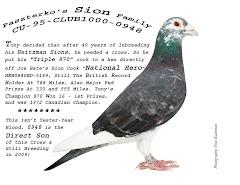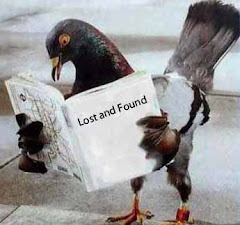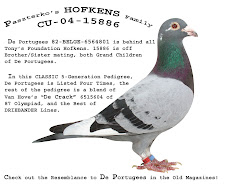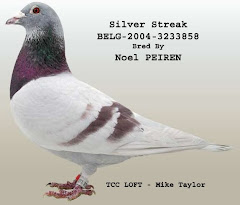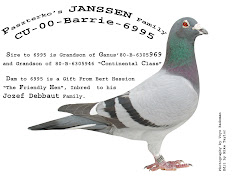Saturday, December 17, 2011
Completed Moult
Thursday, December 15, 2011
History of Racing Pigeons
Saturday, December 10, 2011
Pigeons under attack in Moss Park
Read more ...
Friday, December 9, 2011
Jim Jenner's pigeons
The Rotarian -- December 2011

Fifth grader Kane, with Jenner, is among the Philipsburg, Montana, students taking part in Young Wings. Photo by John Nilles
“I’ve heard every joke,” says Jim Jenner. Those laughs come at the expense of Columba livia, or the rock dove – also known as the humble pigeon. Jenner bristles at the bird’s bad PR, particularly Woody Allen’s famous characterization of pigeons as “rats with wings.”
With their uncanny ability to find their way home from hundreds of miles away, pigeons deserve a little respect, says Jenner, an award-winning filmmaker whose 1990 documentary, Marathon in the Sky: The Story of Pigeon Racing, remains an inspiration for hobbyists. Actor and director Michael Landon narrated the film in exchange for Jenner’s footage of birds in flight, which Landon later used in his TV movie Where Pigeons Go to Die.
Doves, which mate for life, are often a symbol of peace, but as Jenner noted during a speech to England’s House of Commons in 2005, they’ve also played a vital role during wartime, braving flak to carry code across battlefronts. One of the earliest domesticated creatures, pigeons boast a diverse group of famous fanciers, including Charles Darwin, Pablo Picasso (Paloma, his daughter’s name, is Spanish for dove), and Queen Elizabeth II. A program on the Animal Planet network, Taking on Tyson, follows former prizefighter Mike Tyson as he races his pigeons against birds owned by trash-talking wiseguys.
 Thomas, who is featured in Jenner's documentary, is part of a pigeon program in Belgium. Photo by Jim Jenner
Thomas, who is featured in Jenner's documentary, is part of a pigeon program in Belgium. Photo by Jim Jenner"Young Wings, a program Jenner started in 2009, brings children in Philipsburg, a 19th-century mining town, closer to the natural world. Through the program, children raise pigeons in a horse-trailer-turned-pigeon-loft. “This domestic creature, this wonderful, hardy, easy-to-care-for, inexpensive, and profoundly intelligent pet, can fit in with helping kids,” Jenner says.
He is completing a documentary about the program and similar projects, including one for former gang members in South Central Los Angeles and another for juvenile offenders in England.
Pigeons can help “young people become better people,” says Jenner. “I decided to make a film where I would tell a little of my own story and look for evidence that these birds can have a profound effect on children.”
Mike Cutler, superintendent of Philipsburg School District No. 1, says he’s seen how Young Wings has turned things around for some youngsters. “We’re a small community, but we have children from broken families. When those children find a love for pigeons, it kind of replaces things they may not be getting elsewhere. And it has taught the kids about the birds and the bees. It’s been a great science lesson.”
Jenner’s connection with pigeons began at age 10, when a classmate brought a cage with two street pigeons to their school in Seattle. “It was the first time a bird looked back at me,” he recalls. After talking his parents into letting him keep some birds of his own, “I had this responsibility, rain or shine, in all seasons, to take care of them. That teaches a child so much. Here I was, witnessing these very gentle, loving creatures. Their conduct with each other is a beautiful thing.”Besides, “it’s pretty neat to let something out of its cage and let it fly around the house at 50 miles per hour.”
Read more...
Sunday, December 4, 2011
How pigeons produce ‘milk’
Tuesday, 20 September 2011
Deakin University scientists have revealed some of the secrets behind the pigeon’s rare ability to produce ‘milk’ to feed its young.Deakin PhD student Meagan Gillespie and research fellow Dr Tamsyn Crowley, along with colleagues from the University’s Institute for Technology Research and Innovation and CSIRO Livestock Industries, have studied the genes behind pigeon ‘milk’ production. They found that, like mammalian milk, it contains antioxidants and immune-enhancing proteins important for the growth and development of the young.
“Producing milk to feed babies is normally the domain of mammals, including humans. However, the pigeon is one of only three bird species (the others being flamingos and male emperor penguins) to produce a milk-like substance to feed their young,” Dr Crowley explained.“We looked at the genes involved in the production of pigeon ‘milk’ and found that it contains antioxidants and immune-enhancing factors. This suggests that, like mammalian milk, it plays a key role in enhancing the immune system of the developing baby.”Both female and male pigeons produce a nutrient rich substance in their crop to feed their young (squabs). This substance has been likened to lactation in mammals and is referred to as pigeon ‘milk’. This ‘milk’ is essential for the growth and development of the pigeon squab, and without it they fail to thrive.“Bird crops are normally used to store food. However, in the pigeon the crop changes prior to ‘lactation’ in response to hormones and returns to its ‘non-lactating’ state at the end of the lactation period, a bit like the mammary gland,” Ms Gillespie explained.“During ‘lactation’, a curd-like substance is created from fat-filled cells that line the crop and regurgitated to feed the squab. This ‘milk’ contains protein, fats, minerals and antibodies to provide nutrition to the young.”While studies have investigated the nutritional value of pigeon ‘milk’, very little is known about what it is or how it is produced.“This study has provided an insight into the process of pigeon ‘milk’ production by studying the genes expressed in the ‘lactating’ crop,” Ms Gillespie said.“Birds are different to other animals in that they don’t have sweat glands, but they do have the ability to accumulate fat in their outer skin cells (keratinocytes) which act like sweat glands. We found that the evolution of pigeon ‘milk’ appears to have developed from the ability of these outer skin cells to accumulate fat.“The way pigeon ‘milk’ is produced is an interesting example of the evolution of a system with similarities to mammalian lactation, with pigeon ‘milk’ fulfilling a similar function to mammalian milk but produced in a different way.”The results of the study will be published this week in BioMed Central’s journal BMC Genomics.About pigeon ‘milk’The crop in most species of birds is normally used as a food storage area. It is located between the oesophagus and the top of a bird’s stomach where food is moistened before further breakdown and digestion through the gastrointestinal tract.The pigeon is one of only three bird species (the others being flamingos and male emperor penguins) known to produce ‘milk’ to feed their young.In pigeons the milk starts to be produced in the crop of the parent birds two days before eggs hatch.During ‘lactation’, a curd-like substance is created from fat-filled cells that line the crop and regurgitated to feed the squab. This ‘milk’ is made up of protein (around 60 per cent), fat (up to 36 per cent), a small amount of carbohydrate (up to three per cent), a range of minerals and antibodies.Squabs are fed the ‘milk’ until they are around 10 days old. Once the young are weaned the ‘milk’ stops being produced.The unique qualities of pigeon milk have been shown in previous studies.One study tried replicating pigeon ‘milk’ however, for the squabs fed the artificial substance, their growth was either very poor or they died. This suggests that there is a unique quality to the pigeon milk that is necessary for squab growth and development.In another study, when pigeon ‘milk’ was fed to chickens their growth rate improved by 38 per cent. Since this study, it has been shown that pigeon ‘milk’ contains certain antibodies, which provides further evidence that it is not just a nutrient-based substance.
Read more...
Science Alert Australia & New Zealand








